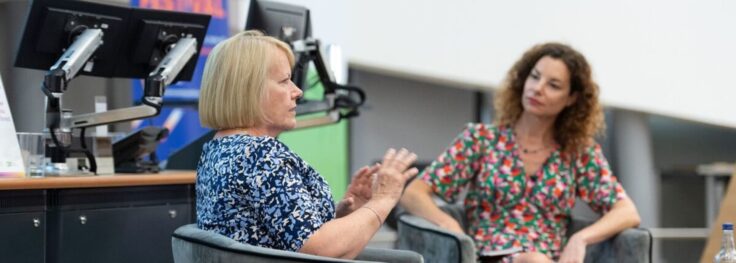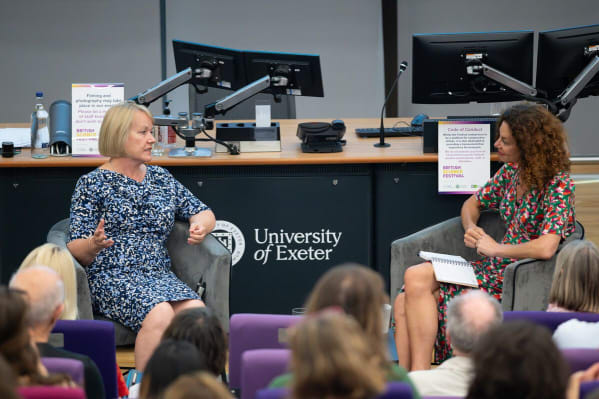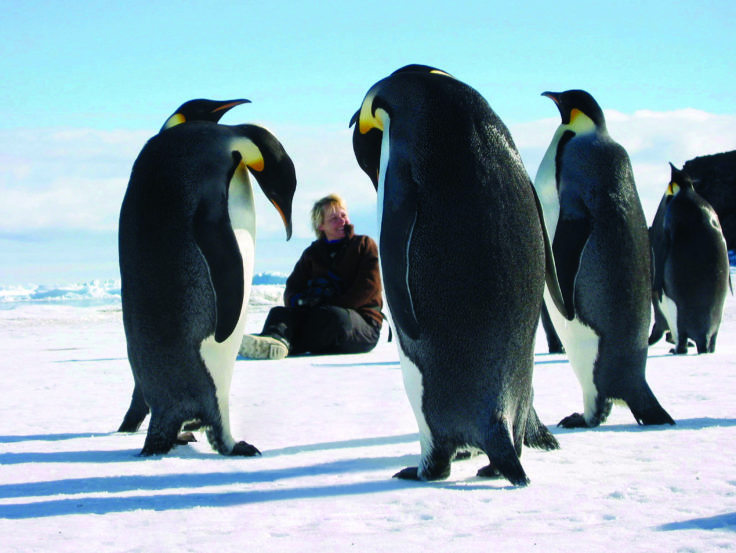Interview with Professor Dame Jane Francis
30 December, 2023 Diversity in UK Polar Science
How does a woman born in 1950s England go on to earn a PhD in geology, spend weeks at a time researching in Antarctica, become the director of the British Antarctic Survey (BAS) and, as of this year, become the president of the British Science Association?
This is the story Professor Dame Jane Francis told journalist, Gaia Vince, at her Presidential Address at the British Science Festival 2023 – held this year at the University of Exeter. Her story is a battle against the discrimination of women in science, about succeeding in a world designed to not let her through the front door. But it is also one of triumph, and gives hope for the future.
A childhood in nature
Jane grew up in the countryside, born to parents in the farming business, so as a small child she enjoyed spending a lot of time out in nature. It was when she was a little older she started to hone her interest and think about how it could become a career.
“I remember being taken on nature rambles by my mother. My brothers and sisters and I would go and jump in trout streams, so we always had nature around us. But when I was in secondary school, I was particularly fascinated by physical geography, about the planet and how it works. That’s when I really decided that a career in geology would be the one that I would take.”
She added:
“I also liked weather and climate, ironically all that time ago, this was in the 70s or earlier… I thought weather, climate, well there’s probably not much future in that, at that time nobody was interested.”
“Maybe they should have been a bit more interested at that time”, Gaia replied.

“Women need not apply”
Jane studied for a degree in geology at the University of Southampton, where she was one of four women in a class of 24. “That was fine – we weren’t treated any differently, to be honest”, she told Gaia.
It was when her course ended, she found that as female geology graduate in 1978, she was explicitly denied the career opportunities afforded to her male peers.
“The first step at that time was to join an oil company, to be a core logger and do the basics of looking at oil extraction, and I do remember a job advert that was pinned on the board and it was for geologists from the University of Southampton to be a core logger and at the bottom it said ‘women need not apply’. That was because in those days, women weren’t allowed to work on oil rigs.”
“It was a bit depressing and I really did think that I’d have to give up geology at that point,” she added.
Luckily an opportunity did come Jane’s way: she was offered a place on a PhD project by a member of the geology department of the University of Southampton working on the rocks of the Dorset coast. “I snapped that up and that’s where I’ve been ever since.”
Slow moving change
Jane is now the director of the British Antarctic Survey, where we “deliver and enable world-leading interdisciplinary research in the Polar Regions.” The institute was born around 60 years ago, its roots lying in “a secret World War Two mission with a dual scientific role”. Jane has been director since 2013.
As Jane discusses the discrimination she faced in the geology world in the 1970s, Gaia points out that it was over 10 years later, in the early 1990s before BAS allowed women to go into the field and stay in research tents. “That’s right”, Jane said.
“I did my first trip to Antarctica in 1989. I was based in Adelaide, Australia as a researcher at that time and I was invited back on a special expedition to go to Antarctica with the British Antarctic Survey… there were several of us women and we actually did camp in the field… but of course that was unofficial because we didn’t actually work for the British Antarctic Survey.”
“I have recently been into the archives at BAS”, Jane said, “and there was this big file which is called ‘Women in Antarctica’ and you would never believe the minutes of some of those meetings, it’s pretty horrendous.”
Things finally changed not long after that:
“There was a male director with foresight and he opened everything up [in the early 1990s] and women then did go to Antarctica. They stayed in field tents and they stayed over winter in stations as well and it made a huge difference because they’re much better and nicer places to work now than they were when they were just men only.”
If that seems late for gender equality to reach Antarctic field world, that’s because it is.
“The Americans and New Zealanders took women into Antarctica in the 1970s.”
Listening to Jane’s story, it’s hard not to imagine the many women who must have lost the battle against discrimination, who are still losing that battle, and the potentially pioneering research they might have done that the world will never get to see.

A great place to study climate change
The climate crisis we’re currently experiencing is human-caused, but over the billions of years of Earth’s history, before humans and industrialisation, the climate has been an amorphous beast. In that time, tectonic plates have moved around, broken apart and formed the land masses we know as continents today, each with their distinct climates.
Over a hundred million years ago, Antarctica was part of a large landmass – or supercontinent – called Gondwana, which included what is now Australia and South America. Gaia asked Jane how Antarctica has changed since that time.
“A hundred million years ago is really quite important because Antarctica was a continent over the South Pole at that time, so when I was doing my field work I was looking at rocks that were a hundred million years old when Antarctica was in a polar position yet I was finding fossil plants, fossil leaves, petrified tree stumps… We have amazing fossils and they all tell us that Antarctica was much warmer at that time because it was green, it had forests.”
“Because the continent has stayed in that same position for the last hundred million years”, Jane explained, “it’s a great place to study because we can see that changes are due to climate change, not because the continents have moved around.”

“When they melt, it sounds like Rice Krispies popping”
The effects of the current climate crisis are most pronounced at the Earth’s poles and Jane has had a front row seat to these changes over the last couple of decades. How does it feel, Gaia asked, to be on the ice caps and hear the gushing water as ice melts?
“About a month ago”, Jane said, “I was in our station in Svalbard – Svalbard is an island north of Norway – we have a research station there… This year I was there for a week and for the whole week I wore a t-shirt.”
“Everybody was saying it shouldn’t be like this. There was really a sense of understanding that this was not good for the environment and you could see in the fjord near our station, there were plumes of glacial meltwater.”
Jane had travelled north with poet laureate, Simon Armitage, and BBC radio producer, Sue Roberts, to record a radio show about the trip.
“We went out one night on a small boat to the foot of the glacier where a huge block had just fallen off. There were lots of bits of ice floating around so we just sat there and listened. When the snow falls, it traps bits of ice that eventually get compressed into these tiny little bubbles in the ice that contain the ancient atmosphere from thousands of years ago. When they melt it sounds like Rice Krispies popping, and it does sound like a big change is taking place.”
Should we be worried?
Antarctica covers 5.5 million square miles – it will surely take centuries to melt. Should we be worried now? Gaia asked. Jane replied:
“That’s what we thought about Antarctica even say five years ago…but a lot of the research we do now is looking at the edges of Antarctica and we do see some changes.”
She elaborated:
“What is happening that we can really see now from our expeditions is that the winds are blowing warm water from the ocean…going underneath the ice shelves [around the edges of Antarctica] and melting it from below. And the worrying thing is as those shelves disappear, the glaciers on land flow down into the ocean. That’s going to affect everybody on the planet who lives near a coast. It will affect the weather, it will affect how our oceans circulate. So, it really will have an affect across the planet.”
Education is key
One thing that can’t be denied is that all of us – especially the generation of young people coming up through the education system today – need a stronger understanding of the climate crisis; why it’s happening and how we can tackle it.
Gaia asked Jane for her thoughts on the 1 in 5 project, an initiative that asks universities to make 1 in 5 of all students’ final dissertations relate to climate change. Jane absolutely supports it and added that we need to create a generation of young people who have comprehensive knowledge:
“Personally, I think it would be really great for everybody who goes to university, whatever subject they do, whether it’s archeology, physics or maths, history or art that they do a module in their first year at university to understand climate change.”
Is university not too late? Not all young people go to university, Gaia posed. Jane agreed:
“I think it’s really important that this is taught in schools because whenever I’ve given talks about climate change, about Antarctica and how it’s changing, I get a lot of feedback from young people who have a sense of huge responsibility on their shoulders – that we’ve created a problem and the solution is theirs [to find], and how are they going to do it. So, I think we need to make sure that everybody knows how climate functions, how our planet functions.”
Follow your dream
What, Gaia asked, is Jane’s hope, as the new President of the BSA, for students studying these subjects today?
“I think we still need to keep on improving the diversity in science, diversity of all kinds, but I think to do science you really need to have passion, you’ve got to really want to do it, and follow your dream. I think that the British Science Association should help people follow their dreams and make sure that the dream is open to as many people as possible in the future.”
Many thanks to the British Science Association, original creators of this blog:
It can be found on their website: Part 1, Part 2